|
Abstract: Mains earthing systems are designed to primarily provide safety by ensuring the user of equipment does not suffer a large voltage difference between two points of contact that are within reach and/or to provide a return path for fault currents. In both situations there is a call for the earthing system to be a low impedance based on the possible currents that can flow during impulses. Providing such a low impedance for 50Hz calls for little more than conductor cross-sectional area, but this approach does not satisfy requirements if the frequency of the impulse is higher than 50Hz. The opposite is not true. Providing a low impedance path for high frequencies is suitable for low frequencies too. Concept: You cannot stop lightning, yet there exists a belief you can! A company was once commissioned to protect a marquee on a golf course where lightning was renowned. At either end of the tent was an over-grown "wire bottle brush" arrangement fed to a decent earth. Lo and behold, lightning struck all around, but not the tent. Thinking that it was just a bit of luck, they waited for a second storm. Again, the lightning behaved exactly as it did the first time. They were on to a winner! They even set up a new company marketing this new-found device that diverts lightning away from an area requiring protection. Then storm number three brewed and everyone on the golf course was beckoned to safe cover. The strike was so vicious that deaths hit double figures, and hospital cases 10 times that. They broke the golden rule of lightning. It has just travelled a few thousand feet. Do you genuinely think there is anything that will stop it travelling the last few? … but you can safely divert the energy.
… it is an application specific hardware and software development company! What is not shown on this aerial shot is the lightning research station that existed off to the top right of the picture! We visited the professor a few times, and it would never cease to amuse him that such a company would set up shop in an area that gave him the highest chance of studying his subject! But this gave us as equal a chance to do the same! When lightning storms approached we would be found, after having disconnected our PCs, standing outside watching lightning hit the lightning rods. Although it is fascinating to see and experience the strike in its entirety (from the build-up right through to the aftershock), the only part of the strikes we found recorded on instrumentation we had set up was when the current flowed. It is therefore only this that we are truly interested in. Research by others has shown that during this time the typical current starts at around 20kA, but it is not uncommon to find some strikes as high as 100kA. As a matter of interest, the highest current recorded in the world is 400kA. With lightning being a discharge between a positively charged area and a negatively charged one has led to the perception amongst some that lightning is DC and therefore treated as such.
Skin effect at 10kHz is a mere 0.66mm meaning that a piece of 10mm x 1.6mm copper pipe actually has more effective area for conducting the lightning impulse than a solid or stranded copper cable of the same outside diameter as there are two surfaces, one on the outside, and one on the inside.
However, specifications tend to quote in mm˛, and are not usually concerned with how the copper is formed. Therefore, if there was a means to increase the surface area by modifying the shape of the copper, but still maintain the area, then this would not only satisfy the 50Hz requirement but improve the 10kHz conduction ability too.
But copper strap has a problem, not in itself, but with those who have to approve its use. The human has this ability to believe that an earth supplied as a thick bulky round cable has more potential to protect than does a flimsy copper strap. But even trying to show that a copper strap has less chance of vaporising (as there is more surface area to keep the copper cool) does not convince some harder nuts in the profession that the strap is better! Maybe this practical study will. Back to our picture.
The first step towards protecting this installations was to create an equipotential plane. This was done using the longest copper strap I think I have ever employed! This went around the perimeter of the building complex, ensuring it encompassed all the lightning rods (which is why there are further straps down what appears to be the centre of sections of the complex). Not only was the strap connected to the earthing system of the lightning rods as it made its way past them, but also to smaller rods placed at every 6 metres along the path of the strap. These rods were 1.8m copper clad steel. The copper made contact with the earth, the steel giving them strength to get slammed into the ground. By the way, these too were connected to this main earth ring by copper strap. With a superb earth in place, the second phase was to protect the equipment. For the servers we opted for protection designed in-house. The reason we never used commercially available devices was that those designed for easy replacement should they go faulty (it's better to have the protection fail than the equipment it is protecting!) had an inherent flaw. Designed for 'replacability', had most devices with both the unprotected and protected wiring on the same side. These had a high 'failure' rate with many devices still suffering damage with a severe strike after the units were installed, yet after the strike the protection was found to still be intact. The manufacturer would blame 'bad grounding'. Until investigated, this made sense. In this next picture we show what happens during the high current portion of the strike. It can be seen that the current is safely brought to earth by the gas discharge tubes. The conductors are, at the same time, emitting a strong magnetic field. This magnetic field slices through the protected wiring setting up a voltage on said wiring. The problem is not the fact this voltage being set up, but the fact there is a clamping device on the output of the protection.
This device becomes, as designed, a low impedance when it clamps and therefore causes all the induced current to be wielded in the direction of what is meant to be protected (some protection, hey!?). The other undesired aspect of this style of protection is the density of the protection is automatically halved as the output needs to be taken through the same connector that feeds the input to the printed circuit board. Our protection (pictured below) had the input fed from cable termination blocks, and the protected side fed via a simple connector off the opposite other end of the board. The reason this was not swapped is should the board be unplugged, the earth is disconnected and the unprotected cabling would now be free to spark across to anything it could reach.
With our design, the danger of induction from the unprotected to the protected cabling was drastically reduced and, as the system was designed for 19" racks, meant the protected outputs were suitably available for the equipment housed within the 19" cabinets (you will also notice the final stage was removed which was earlier shown to be a problem). The success of this protection has been proved in the fact it was copied - albeit very badly. The plagiarist forgot to connect the ground plane between the gas arrestors through to the ground on the other side of the connector (they used an inferior CAD package). Even though they did a botch job, I still took it as one heck of a compliment that my design was cloned! Individual PC protection was provided by commercially available units, carefully selected to conform to the methods employed on the larger multi-line protection as shown earlier. One common failure found when investigating other premises suffering damage after a lightning impulse was the PSU would die even though there was protection on the power and all signal lines into the PC. A typical configuration shown here.
There is a policy that dictates the correct installation of any impulse protection called the "bottle-neck" approach. If one thinks of a bottle neck, nothing gets into or out of the bottle other than through the neck (it is best to view the bottle upside down!). Here is an example of what is meant by this. It will be seen that all protection is kept at one end of the equipment. Any currents that are found on the earth of the protection will flow no further than the earth bar. Little will be found running through the equipment. It must not be forgotten that the earth bar is to be viewed as an inductor and that lightning is AC meaning the earth bar must be kept as short as possible. Please note that there are some that believe that should the equipment be encased in metal they can avoid this rule. Let us investigate what happens. When the impulse occurs, the currents flow along the casing setting up a serious magnetic field therefore subjecting the circuitry inside the case to it. Should the circuitry contain something like an EEPROM or other non-volatile memory then the non-volatile characteristic is severely tested! Such a fault was found on a telemetry unit near a railway line. The device was underground with the antenna, obviously (as this was radio), on the surface. There was this belief that as the unit was "all metal" the antenna was earthed through the casing and via the earth terminal on the other end of the unit. Just having a railway line nearby was sufficient to cause the unit to 're-program' the 'non-volatile' memory and take the unit off the air. Back to our PCs; Special power cords were ordered. Their two characteristics were they were very short (500mm) and they had an earth cable tapped off from inside the mains power plug which was used for the protection. Being short they picked up very little magnetic radiation from the lightning rods when struck, and having the earth tapped on the plug meant there was little chance of potential difference across each of the PCs ports. With the currents now flowing totally outside the PC case, damage was eliminated. Reasons for Installing Impulse Protection >>
© 00.00.03 |
 SOLUTIONS:
SOLUTIONS: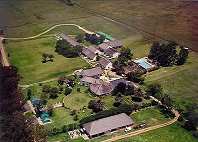 After the next story, you are welcome to call me an ‘anorak’ if you wish. Pictured is a site where I once worked. It is a "country based office complex". What is not visible is the multitude of 25 metre high lightning rods that are designed to hopefully attract the lightning away from the thatch roofs and thereby reduce the risk of fire. The fun part is…
After the next story, you are welcome to call me an ‘anorak’ if you wish. Pictured is a site where I once worked. It is a "country based office complex". What is not visible is the multitude of 25 metre high lightning rods that are designed to hopefully attract the lightning away from the thatch roofs and thereby reduce the risk of fire. The fun part is… 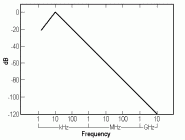 Lightning is far from DC. It is, in fact, an AC waveform with a typical centre frequency of about 10kHz. Based on this, we need to investigate an aspect of the conductors that are required to conduct this current.
Lightning is far from DC. It is, in fact, an AC waveform with a typical centre frequency of about 10kHz. Based on this, we need to investigate an aspect of the conductors that are required to conduct this current. 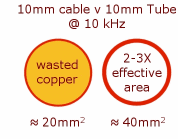 Although the tube has improved the ability to conduct lightning, i.e. 10kHz, the ability to carry any 50Hz component is now restricted to the 40mm˛ indicated. The ability to conduct fault currents has therefore also been reduced and may be called into question if any relevant specification is applied.
Although the tube has improved the ability to conduct lightning, i.e. 10kHz, the ability to carry any 50Hz component is now restricted to the 40mm˛ indicated. The ability to conduct fault currents has therefore also been reduced and may be called into question if any relevant specification is applied.  In steps the copper strap. In the example shown a 50mm x 1.5mm strap has as much area as a 10mm diameter round cable. Furthermore, all of this area is available for conducting the lightning energy. What it also has is >100mm of surface area for frequencies above 10kHz, compared with only 30mm found on a round cable with the same cross-sectional area.
In steps the copper strap. In the example shown a 50mm x 1.5mm strap has as much area as a 10mm diameter round cable. Furthermore, all of this area is available for conducting the lightning energy. What it also has is >100mm of surface area for frequencies above 10kHz, compared with only 30mm found on a round cable with the same cross-sectional area. 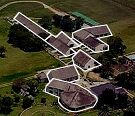 This property, as you may recall, is occupied by a specialist hardware and software development company. This means a lot of computers and sophisticated peripherals are on site. You will also remember this site was close to a lightning research station. A computer company and no lightning protection!? One could almost say that this is like a motor mac making sure the Rolls in the service bay leaves in pristine condition, but his own buggy not having a snowball's hope in hell of passing an MOT!
This property, as you may recall, is occupied by a specialist hardware and software development company. This means a lot of computers and sophisticated peripherals are on site. You will also remember this site was close to a lightning research station. A computer company and no lightning protection!? One could almost say that this is like a motor mac making sure the Rolls in the service bay leaves in pristine condition, but his own buggy not having a snowball's hope in hell of passing an MOT! 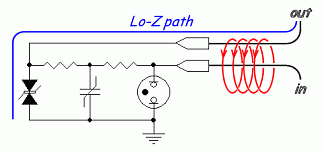
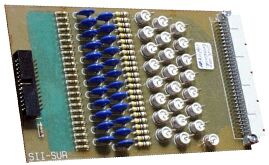
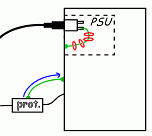 The failing was that any impulse clamped by the signal line protection was fed to the case of the PC. This energy had only one path to earth, this being through the power cord. However, in order to get to the power cord it would have to go via the link found between the back of the power socket and the PC case, this found inside the PSU compartment. With quoted currents of 20kA being conducted, it comes as no surprise that some components found life very uncomfortable in the magnetic field emanating from this link.
The failing was that any impulse clamped by the signal line protection was fed to the case of the PC. This energy had only one path to earth, this being through the power cord. However, in order to get to the power cord it would have to go via the link found between the back of the power socket and the PC case, this found inside the PSU compartment. With quoted currents of 20kA being conducted, it comes as no surprise that some components found life very uncomfortable in the magnetic field emanating from this link.